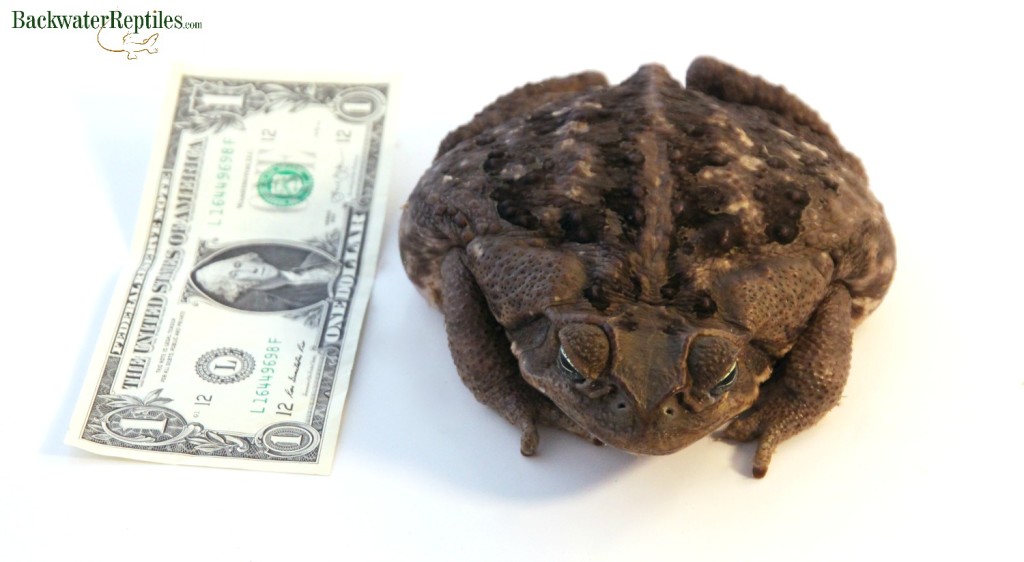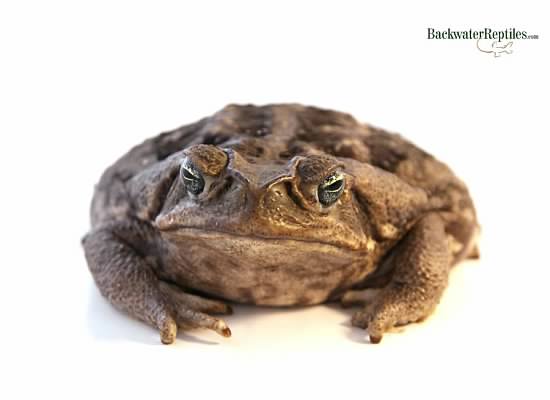Cane toads (Bufo marinus/Rhinella marina) have a rich history and are perhaps the most well known (or notorious) toad in the world. They’ve earned a rather bad reputation as invasive and detrimental to natural ecosystems. This is largely due to the attempt to use them to control cane beetle populations in Australia…but more on that later.
These behemoth amphibians are best known as “Cane” toads because they originally helped eradicate pests from sugar cane fields. However they’re also called “Marine” toads by some, and even “Bufo” toads by Floridians.
For the purposes of this blog, we’re going to give a brief history of the cane toad and discuss what has given this hardy toad such bad notoriety. We’ll also go into detail about how this affects the pet trade and what you can do to be a responsible pet owner if you wish to keep cane toads of your own.
A Brief Description of the Cane Toad
Cane toads (also called Marine Toads and Giant Neotropical Toads) are known for their dry, bumpy skin and large size. Overall, they are fairly unremarkable-looking brown toads, but they certainly pack a punch when it comes to defense mechanisms.

Toads don’t have many natural defense mechanisms. They lack claws, sharp fangs, or stingers to fight back against potential predators. However, cane toads are actually quite poisonous. They possess glands that secrete a poison called bufotoxin through their skin which is extremely toxic. This means that most potential predators have learned not to mess with cane toads as they can die from ingesting the poison on the cane toad’s skin.
Because they lack predators that can actually stomach their toxic skin in many environments, cane toads live quite long and can grow quite large in the wild. This is doubly true in captivity where feeding time and environment are highly regulated.
A single adult cane toad will average anywhere from four to eight inches in length, although the largest specimen recorded was actually fifteen inches long from snout to vent! In the wild, they can live for ten to fifteen years with considerably longer lifespans when kept as pets. South American Marine toads (same species) attain absolutely massive sizes.
History of the Cane Toad
As we’ve already established, cane toads are considered an invasive species in many areas and have therefore gained a reputation as pests that are harmful to local ecosystems. While this is not untrue, man is partially to blame for this occurrence and we think it’s unfair to vilify the cane toad just for being so successful at surviving.
Because the cane toad is such a voracious eater, it has been introduced into regions of the world as an agricultural pest control method. These cases of introduction have been well documented and the cane toad might be the best studied of all introduced species cases.
After relative success with cane toad introduction into Puerto Rico and Hawaii, cane toads were introduced to Australia in 1935. This is probably the most famous case of cane toad introduction because it had such a massive impact on the native ecology.

The release of the toads into Australia might have been considered successful if the toads actually brought down the population of the targeted insect, the grey-backed beetle. However, because the cane fields offered little shelter to the toads during the day and also because the beetles lived in the tops of the fields and cane toads are not good climbers, the toads ended up eating everything en masse but the targeted insect.
Nowadays, cane toads are considered pests in Australia with their population numbering well into the millions. Australian governments have even asked residents to help out by collecting and disposing of the animals.
Owning a Cane Toad as a Pet
Because cane toads are so populous, their numbers are not in danger of declining if people collect them for pets. In fact, we think it’s more humane for them to be kept as pets than “eradicated” for being too successful at breeding and populating.
Because cane toads historically can thrive in such a variety of habitats and consume just about anything, they are exceptionally hardy pet amphibians. They have very easy care requirements which means they make great classroom pets and also great pets for children.
Just be aware that due to the toxin they can secrete, you’ll want to make sure that they are not handled with excessive force as this can trigger the toxin to be secreted.
We would also advise always washing your hands after handling any animal (not just reptiles and amphibians) to help prevent Salmonella contamination, as well as to wash away any potential bufotoxin from the Cane toad itself.

That being said, we do not ever recommend releasing any cane toad (or other pet reptiles/amphibians) into the wild. For example, unless you can guarantee that your pet cane toad will not be able to breach the walls of your back yard, we do NOT recommend setting up an outdoor enclosure where they can live in a natural setting. There is just too much controversy surrounding their invasiveness and the potential for human error.
Conclusion – Cane toad history
Cane toads may not be the world’s most treasured amphibian, but because they’re so adaptable, we think they can be fun and entertaining pets to anyone who has a love for toads. We hope you’ve enjoyed our article on Cane toad history and consider yourself more knowledgeable when it comes to these tremendous amphibians.
If you’re interested in obtaining a pet cane toad, Backwater Reptiles has these gigantic amphibians for sale to responsible hobbyists.
